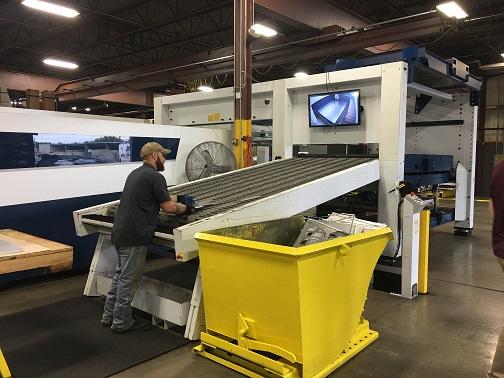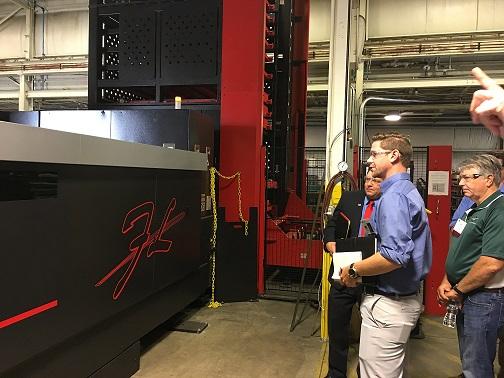Editor-in-Chief
- FMA
- The Fabricator
- FABTECH
- Canadian Metalworking
Categories
- Additive Manufacturing
- Aluminum Welding
- Arc Welding
- Assembly and Joining
- Automation and Robotics
- Bending and Forming
- Consumables
- Cutting and Weld Prep
- Electric Vehicles
- En Español
- Finishing
- Hydroforming
- Laser Cutting
- Laser Welding
- Machining
- Manufacturing Software
- Materials Handling
- Metals/Materials
- Oxyfuel Cutting
- Plasma Cutting
- Power Tools
- Punching and Other Holemaking
- Roll Forming
- Safety
- Sawing
- Shearing
- Shop Management
- Testing and Measuring
- Tube and Pipe Fabrication
- Tube and Pipe Production
- Waterjet Cutting
Industry Directory
Webcasts
Podcasts
FAB 40
Advertise
Subscribe
Account Login
Search
The need to automate
The FABRICATOR’s Technology Summit shows what automation means to Cleveland fabricators
- By Dan Davis
- October 10, 2017
- Article
- Laser Cutting

Figure 1. American Engineering and Metalworking, North Canton, Ohio, has found automated sheet delivery and parts removal systems on its two lasers to be useful tools in helping to keep cost per part down.
Kirk McCauley, owner of American Engineering and Metalworking (AEM) in North Canton, Ohio, was thinking about the movie “City Slickers” after the first day of touring fabricating operations as part of The FABRICATOR’s Technology Summit in Cleveland Oct. 3-4.
No, Billy Crystal didn’t make a cameo during one of the four stops at area manufacturing companies. But some of the fabricators on the tour had been talking about the desire to see some automation in these facilities. After all, the two-day event was billed as “Setting the world in motion with automation.”
That caused McCauley to wonder why automation was so important to his and other shops. That made him think of the “City Slickers” scene in which Billy Crystal’s character asked Curley, played by Jack Palance, “Do you know what the secret of life is?” In the movie Palance held up his gloved index finger and said, “One thing. Just one thing. You stick to that and everything else don’t mean s**t.” Crystal wanted to know what the one thing was, but the wise old cowboy responded that was something he had to figure out on his own.
McCauley knows what that one thing is when it comes to investing in automation: cost per part.
“The best decision you can make is to get that best cost per part and be more competitive,” he told his peers as they were about to tour his facility.
Inside AEM, one of the first things visitors notice are the two TRUMPF lasers with not only automated load and unload systems, but also part and skeleton delivery conveyors to the machine operators (see Figure 1). AEM purchased its TRUMPF 5030 laser cutting machine with its 5-kW, solid-state power source, the TruDisk 5001, and the material handling system almost three years ago. The efficiencies gained by having the operator sort parts, even with the new laser’s robust cutting speeds, were so great that management decided to add the material sorting system to its older CO2 system. To make room for it, the fabricator also sold one of its older laser cutting machines.
“When you can reduce that cost per part,” McCauley said, “you can put money in your wallet.”
That’s not the only area in which the company has invested to minimize manual activity on the shop floor. In its new 12,000-square-foot addition, it has a large robotic welding cell that can accommodate parts 8 ft. wide and up to 40 inches in diameter. A new automated deburring machine is helping to round off edges on laser-cut parts and apply polished surfaces and otherwise make life easier for those folks who used to have to do that chore by hand. In the future, AEM is going to take a look at ways of automating hardware insertion because assembly services is a growing area of the business.
At another tour stop at Weaver Precision Fabricating and Finishing, Akron, Ohio, attendees got to see just how automation can affect the front office as well. When the shop upgraded its equipment about three years ago, it also invested in programming software. Now the company can automate several programming steps that used to take hours, according to Weaver’s Rich Stetler.
The SheetWorks software, which came with its Amada 2-kW fiber laser cutting machine and its 135-ton Amada press brake, extracts information from a solid model and creates a flat pattern that will be used for cutting and bending programming. When a customer submits a 2-D drawing, the software often can manipulate the different views to create a model that then can be used to create the flat pattern.

Figure 2. The FABRICATOR’s Technology Summit attendees had the opportunity to see a fiber laser cutting machine and its accompanying 10-shelf material tower in action at Weaver Precision Fabricating & Finishing, Akron, Ohio.
When that pattern is moved over to the equipment’s Dr.ABE software, the programmer really can see how the software makes manual programming look so inefficient. After a quick survey of the flat pattern, the software is able to coordinate the job assignment, sequencing, and NC generation for the job. The nest is ready to go for the laser cutting machine, and because the software is integrated with Weaver’s ERP system, a shop router also is created. When the part file is pulled over into the software’s bending program, instructions for the press brake, which include details such as tooling type to be used, bend directions, and bend deduction values, are created.
From there, parts are ready to be cut. A 10-shelf materials and parts storage tower (see Figure 2)—with seven shelves reserved for raw material and three reserved for finished parts—attached to the fiber laser cutting machine makes it possible for the parts to be cut overnight or on the weekend when no one is around. In about 90 seconds, the system moves cut parts from the laser cutting machine’s bed to a tower shelf and places a fresh sheet on the machine.
Marian Lauer, one of the company owners, said the new laser cutting setup is important because the firm is now able to stock different material types in the tower and run those different types of sheets on unattended shifts because the laser cutting machine can adapt cutting parameters automatically for the different jobs.
In addition to the stops at AEM and Weaver, fabricators had the chance to visit Lincoln Electric, Cleveland; Cres Cor, Mentor, Ohio; Meyer Plow Products, Cleveland; May Industries, North Royalton, Ohio; Mayfran Intl., Cleveland; and Fabricating Solutions, Twinsburg, Ohio.
If you are interested in the 2018 edition of The FABRICATOR Technology Summit and its associated tours, call 888-394-4362.
About the Author

Dan Davis
2135 Point Blvd.
Elgin, IL 60123
815-227-8281
Dan Davis is editor-in-chief of The Fabricator, the industry's most widely circulated metal fabricating magazine, and its sister publications, The Tube & Pipe Journal and The Welder. He has been with the publications since April 2002.
subscribe now

The Fabricator is North America's leading magazine for the metal forming and fabricating industry. The magazine delivers the news, technical articles, and case histories that enable fabricators to do their jobs more efficiently. The Fabricator has served the industry since 1970.
start your free subscription- Stay connected from anywhere

Easily access valuable industry resources now with full access to the digital edition of The Fabricator.

Easily access valuable industry resources now with full access to the digital edition of The Welder.

Easily access valuable industry resources now with full access to the digital edition of The Tube and Pipe Journal.
- Podcasting
- Podcast:
- The Fabricator Podcast
- Published:
- 04/30/2024
- Running Time:
- 53:00
Seth Feldman of Iowa-based Wertzbaugher Services joins The Fabricator Podcast to offer his take as a Gen Zer...
- Industry Events
Pipe and Tube Conference
- May 21 - 22, 2024
- Omaha, NE
World-Class Roll Forming Workshop
- June 5 - 6, 2024
- Louisville, KY
Advanced Laser Application Workshop
- June 25 - 27, 2024
- Novi, MI































